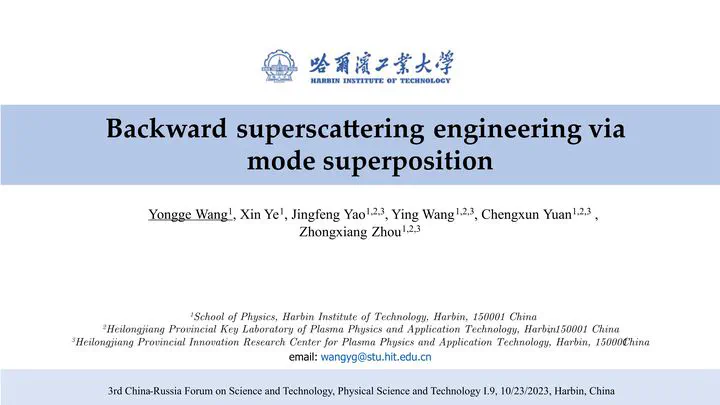Backward superscattering engineering via mode superposition
Oct 22, 2023·1
,1
,1,2,3,‡
,1,2,3
,1,2,3,§
,1,2,3,∥
Yongge Wang
Xin Ye
Jingfeng Yao
Ying Wang
Chengxun Yuan
Zhongxiang Zhou
${}^1$School of Physics, Harbin Institute of Technology, Harbin 150001, People’s Republic of China
${}^2$Heilongjiang Provincial Key Laboratory of Plasma Physics and Application Technology, Harbin 150001, People’s Republic of China
${}^3$Heilongjiang Provincial Innovation Research Center for Plasma Physics and Application Technology, Harbin 150001, People’s Republic of China
Harbin, China

Abstract
Subwavelength particles with a total scattering cross-section exceeding the single channel limit are called super scatterers, which can provide the ability to control light at the nanoscale. Superscatters have been constructed in different regime such as electromagnetic waves, acoustic system, and water waves. Recently, various of structures for superscatterer have been proposed, but most of which are typically constructed with negligible backscattering, in sharp contrast to its significant forward scattering, which limits further applications. The mainly proven capability of superscatterer is protecting the objects behind it off scattering[3]. we examine this overlooked phenomenon in a 2D rotational symmetric system and find that this behavior can be attributed to the superposition of resonant modes in adjacent angular momentum channels. In the process, we outline a general perspective on the relationship between the forward and backward scattering and mode combinations. Specifically, we will demonstrate enhancing backscatter beyond the reach of single channel by recombining resonant modes in a simple model.
Date
Oct 22, 2023 1:00 PM
Event
3rd China-Russia Forum on Science and Technology